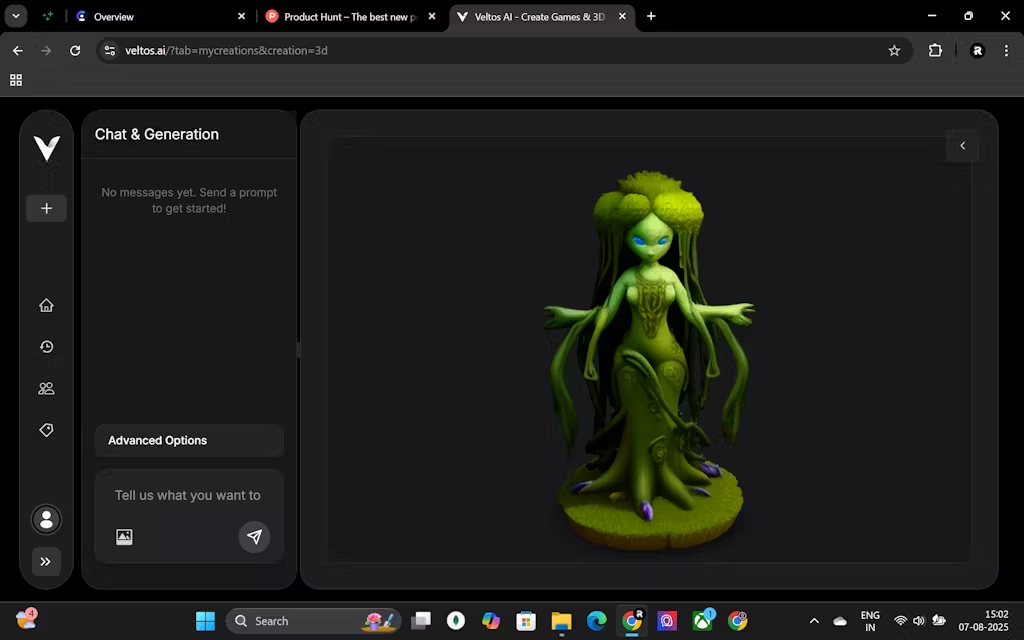Veltos.ai is an artificial intelligence platform that allows users to create games and 3D worlds with simple text prompts. The core idea of this tool is to make game creation easy, and users don't need to have programming or complex design skills. Whether you're a gamer, a story creator or a beginner interested in development, you can utilize the platform to transform your ideas into playable, interactive experiences in minutes. Through its artificial intelligence technology, Veltos.ai understands the user's natural language descriptions and automatically generates the appropriate game environments, 3D models and virtual worlds.

Function List
- Text Generation Game: Users can generate complete games by entering simple text descriptions. For example, a "Flying Birds in a Jungle Environment" game can be created.
- 3D World Creation: Rapidly build immersive 3D environments using natural language commands. For example, generate a "garden with butterflies".
- 3D Model Generation: Individual 3D models are generated based on textual descriptions, e.g. "a banana shaped airplane".
- no-code operation: The entire creation process does not require writing any code, lowering the barriers to game development.
- Quickly turn ideas into reality: The ability to quickly transform a user's ideas into digital content that can be interacted with.
Using Help
Veltos.ai is designed to simplify the process of creating games and 3D worlds, making it easy for users without a professional background to get started. The entire platform is centered around the core functionality of "text prompts".
Core Operational Processes:
- Access to the website: First, open the official Veltos.ai website. The website interface usually has a very prominent input box, and this is where you interact with the AI.
- Conceptualize your idea: Think about what you want to create before you start. The more specific your idea is, the more likely the AI-generated result will match your expectations. You can conceptualize a simple game, a unique 3D scene, or an interesting 3D model.
- Enter text prompts: In the input box, clearly describe your idea in natural language. When describing, you can include the following key elements:
- thematic: What is it that you want to create? (e.g. a game, a scenario)
- core object: What is the main character in the scene or game? (e.g., a bird, an airplane)
- matrix: Where does the story take place? (e.g. jungle, sky, garden)
- hairstyle: What do you want it to look like? (e.g. cartoon style, pixel style)
- Interactive approach(for games): What is the basic gameplay of the game? (e.g., tap the screen to make the bird fly)
- Generate & Preview: After entering the prompt, click the Generate button. the AI will start processing your request, a process that may take some time. When it's done, the platform will show an interactive preview version. You can experience the game you created or explore the 3D world you designed directly in your browser.
Example of specific function operation:
- How to create a simple game?
- goal: Create a simple game like "Flappy Bird".
- input prompt: In the input box, type "Create a game where a bird flies through a jungle and the player has to click to make the bird fly upwards and avoid obstacles".
- Adaptation and Iteration: If the initial generated results are not exactly as expected, you can try to modify your hints. For example, you could change the setting: "Create a game where piglets fly through a city" or increase the difficulty: "Obstacles are moving pipes".
- How to generate a 3D model?
- goal: Design a 3D model with a unique shape.
- input prompt: Directly describe how you want your model to look, such as "a 3D airplane model in the shape of a banana" or "a robot with cat ears".
- View Model: Once generated, you can view your model from different angles in a 3D viewer.
- How to build a 3D world?
- goal: Create a virtual scene that can be explored.
- input promptDescribe the details of the scene you have in mind, e.g. "a peaceful Japanese garden with bridges, running water and falling cherry blossoms".
- Discover the world: Once generated, you'll be able to roam around the scene in a first or third person view of the world you've created.
Practical Tips:
- Use clear verbs and nouns: AI is more likely to understand specific instructions. Use words such as "create", "design", "generate", etc., and specify objects and environments.
- create in stages: If you want to build a complex world, start by generating a core scene and then gradually add more elements.
- Start simple.: If you're a first-time user, start by generating a simple 3D model to familiarize yourself with how AI works before trying to create more complex games and worlds.
application scenario
- Game developers and enthusiasts
For indie game developers or hobbyists, Veltos.ai can be used as a tool to quickly realize game prototypes. They can utilize the platform to validate the playability of a game idea in minutes, without having to invest a lot of time and resources into programming and art design. - Education and learning
In the field of education, teachers can utilize Veltos.ai to show students the basic concepts of game design. Students can visualize what makes up a game world through simple text descriptions, sparking their interest in programming and creative design. - Writers and storytellers
Writers and content creators can transform the scenes and worlds they write into visible 3D environments with Veltos.ai, providing a new immersive experience for their readers or as a source of inspiration in the creative process.
QA
- Do I need to pay to use Veltos.ai?
There is no clear pricing information on the website, but similar AI services usually offer a free trial amount, beyond which or premium features may be charged. It is recommended to visit the official website directly to get the latest pricing strategy. - Can the games and models I create be exported for use?
The information searched so far focuses on the platform's generative capabilities and does not detail whether exporting models or publishing games to other platforms is supported. This is often one of the key features of such platforms and it is recommended to look for this information in the official documentation or in the community. - Who owns the copyright of the generated content?
Regarding copyright ownership of generated content, different platforms have different policies. Usually, users have certain rights to use the content they create, but the specific terms need to refer to the service agreement of the website. - What if I am not satisfied with the results generated?
Artificial intelligence generates results with a certain degree of randomness. If you are not satisfied with the initial results, try modifying and optimizing your text prompts to make their descriptions more specific and clear. Multiple attempts usually yield results closer to expectations.


































